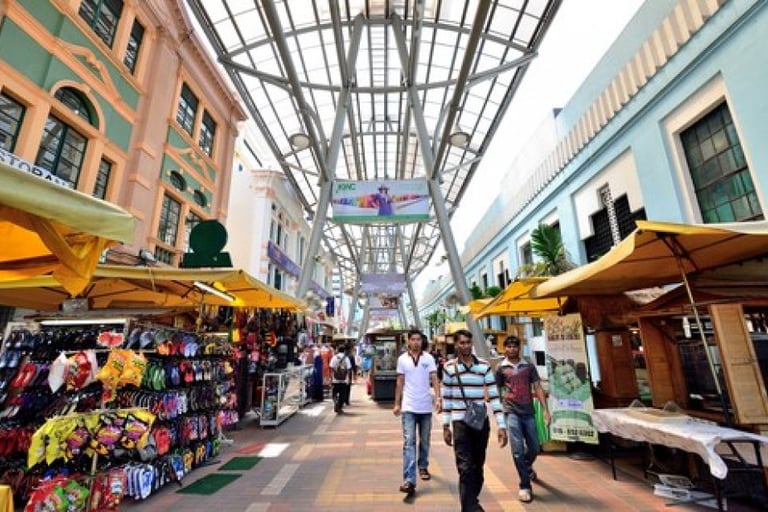
When Architecture Meets the Spirit of Ramadan: Between the Authenticity of Heritage and the Sustainability of the Future
This article aims to analyze tangible experiences in modular construction, while presenting real statistics and results that can benefit specialists in the field.
Construct Vision Team
2/25/202515 min read
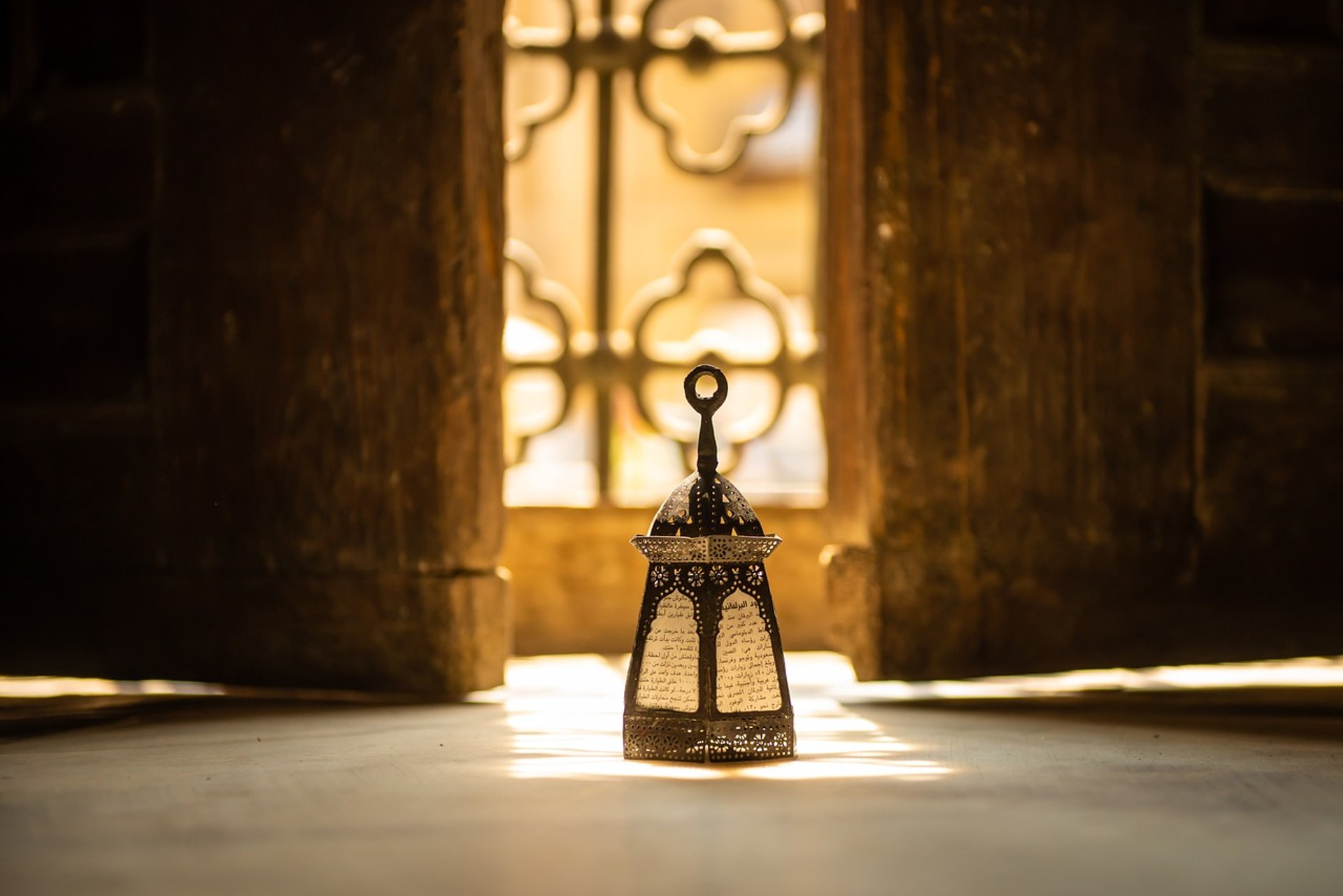
Introduction:
With the advent of Ramadan, the rhythms of cities change, and public spaces become vibrant centers where spirituality and social gatherings merge. Markets are bustling with shoppers, mosques are filled with worshippers, and homes embrace lavish tables that bring together families and friends.
But, in the midst of architectural and technological transformations, how can architecture preserve the spirituality of Ramadan without losing its identity in the face of modern developments? And can urban sustainability be a bridge between the authenticity of heritage and the requirements of the future?
In this article, we will explore how the atmosphere of Ramadan meets urban architecture, and how technology, heritage, and sustainability can be integrated to create environments that harmonize with the Ramadan dimensions, as traditional environments did, while preserving their identity and adapting to modern changes. We will take a look at markets, mosques, homes, and public spaces, and study how they can be designed to be more efficient, sustainable, and in harmony with special seasons. We will also review some experiences in embodying this concept.
Can modern architecture be an extension of traditional architecture with a more modern and sustainable spirit?
Social Safety Factor Between the Past and the Present:
Old markets formed safe spaces for social interaction, as they were characterized by a design that provided safety, such as narrow alleys that facilitate social supervision, natural lighting, and organization around mosques and inns to ensure active and sustainable movement. This movement includes all social classes in a natural way, where every individual, regardless of their social or financial class, finds their needs, without feeling any distinction between them and other individuals. Here, social relations are formed that provide a psychological safety factor, whether for shop owners or market visitors.
Studies indicate that the presence of open markets and social councils reduces the rate of simple crimes by 25% during seasons due to increased social interaction.
Here we find a huge difference between these markets and the markets of the modern era, which have turned into large malls, where this distinctive interaction has been lost, and different commercial relations have emerged with their positives and negatives.
We also mention the mental image of mosques as centers of tranquility and social safety, as in the past, mosques were more than just places of prayer, but were also shelters for the needy, and schools for the poor, in addition to the presence of reading halls, and other multiple uses. This enhanced the sense of safety and belonging.
Despite the continuation of the role of mosques, some modern designs did not take into account these needs (for example: limited spaces, complete separation between spaces, and the absence of large courtyards).
Public spaces in old cities, such as markets, inns, squares, and scientific institutes surrounding mosques, contributed to the creation of cohesive and safe communities, where everyone is under the eyes of each other.
Today, the disappearance of some of these open spaces has led to a decline in social interaction and an increase in the feeling of isolation, and has enhanced privacy and separation between individuals. So, does modern architecture enhance social safety or reduce it? And can modern cities reintegrate these elements to provide similar social safety to what existed in the past?
Economic Dimension and the Impact of Architecture on Economic Activity During Ramadan:
In the past, traditional public spaces were designed flexibly to accommodate increased activity during Ramadan and other occasions, with provision of spaces for street vendors, which enhanced the city's economy. To this day, old cities contribute to these seasons with an effective economic role. And the presence of mosques in the heart of old markets gave them an economic role as attraction points, where commercial activity increases around them especially before and after prayers.
Today, the general scene of modern markets and malls does not change throughout the year despite the difference in the degree of demand during the holy month? And do not interact with neighboring spaces and events in a vital way. The closed designs of malls have affected the spirit of the open market that enhanced economic interaction. As for prayer places, they are present in markets as a service place where an individual can perform prayers in case of need. As for the main mosques, the modern urban planning style separated them from the economic cycle of the city.
Open squares and markets in old cities accommodated traders and temporary restaurants, providing them with seasonal economic opportunities. Today, in modern cities, are there enough spaces to support Ramadan activities such as collective iftar, night markets, and shopping festivals?
In some Arab countries, spending on shopping increases by 30-50% during the month of Ramadan, making Ramadan markets a vital element in the economy. In 2023, the value of spending on food and drink in the Gulf during Ramadan was estimated at $6 billion.
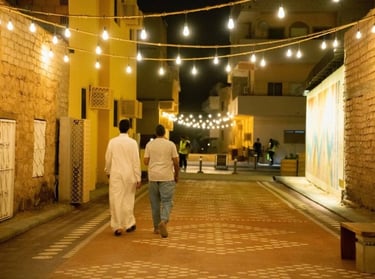

It is worth mentioning here that many modern experiments have tried to find a balance between sustainable markets in Ramadan that link between traditions and old Ramadan markets, and the challenges facing modern markets in achieving sustainability, especially with the increasing reliance on technology and digital services.
We will mention several cases briefly:
Traditional Markets as a Source of Inspiration for Sustainability
Souq Waqif - Doha, Qatar
This traditional market is characterized by the use of local building materials such as clay and stone, which helps maintain a moderate temperature. It relies on narrow and shaded alleys, which reduce direct exposure to the sun and provide a more comfortable environment for shoppers.
The design allows for the flow of natural air, which reduces the need for artificial air conditioning. Natural lighting is utilized through upper openings during the day, which limits electricity consumption.
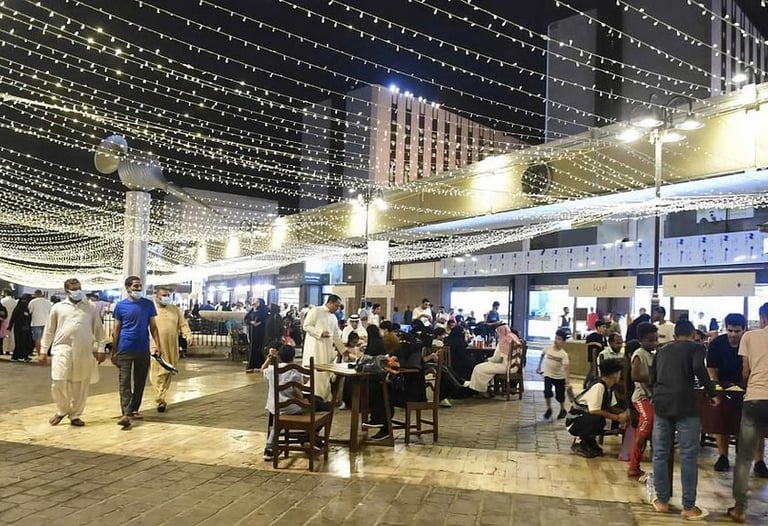

Khan El-Khalili Market - Cairo, Egypt
Built on an area with varying heights, which makes some alleys slightly higher or lower than others. This gradient creates a difference in air pressure, which pushes air to move between the alleys, thus improving natural ventilation. The streets are narrow and winding, which helps increase the speed of the wind between the buildings.
Stone materials reduce heat absorption compared to modern glass buildings. The market combines open and closed commercial spaces, creating a flexible environment for use in seasons and otherwise."
Modern markets that apply the principles of sustainability
Masdar City Market - Abu Dhabi, United Arab Emirates
Masdar City Market relies on solar energy as the main source of energy. The buildings in the city in general are designed to take advantage of natural ventilation using traditional air systems. The market uses local building materials such as clay bricks that help with thermal insulation and employs passive environmental design so that excess heat accumulates in building materials to be used at night, which maintains a constant temperature inside the market.
The city as a whole relies on sustainable transportation, including electric cars and zero-emission vehicles.
Riyadh Boulevard Market
It uses energy-saving LED lighting technology with a design that adapts to peak times in Ramadan. The market is designed to be flexible, so that it transforms during Ramadan into a social and entertainment destination that meets the needs of visitors.
Smart shading technologies have been integrated to protect shoppers from scorching sunlight.
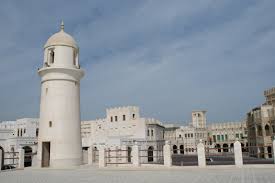

Share the post
Subscribe to our newsletters:
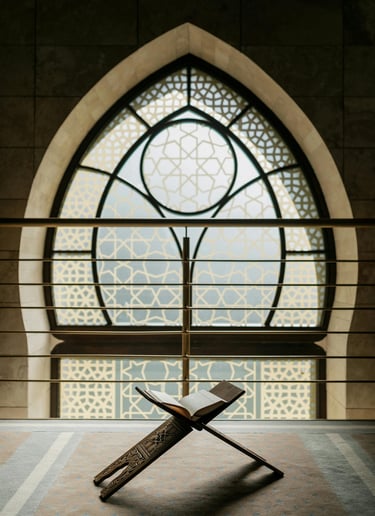

The Impact of Technology on Spaces in Seasons:
Markets and Shopping Malls in the Digital Age
In the past, traditional markets were the economic heart of Islamic cities, especially during Ramadan, where there is an increased demand for food, clothing, and Ramadan products. With the spread of smart applications and delivery services, the need for physical markets has gradually changed. But has modern architecture been able to provide a social environment during the holy month?
Traditional markets enjoyed a design that allowed for social interaction and ensured the availability of safety while engaging in various activities for all members of society. The narrow alleys made goods accessible to everyone and provided thermal comfort, while the open spaces accommodated congestion and constant movement.
Modern malls, although they provide an integrated shopping experience, their closed design may reduce the element of social interaction that characterized traditional markets, and confine the use of the market to a specific category of society.
Here, the challenge of balance arises. How can contemporary architects design markets that combine technological character and social interaction, without losing the spirit of the Ramadan market?
Smart Mosques Between Spirituality and Technology
Mosques witness a large influx during Ramadan, which requires thinking about smart architectural designs that help accommodate large numbers and reduce resource consumption. Some of the solutions that have emerged are:
• Using smart lighting and air conditioning systems that adapt to the number of worshippers to save energy, making mosques more efficient during the congestion in Ramadan. These systems rely on self-control and efficient air direction.
• Digital screens, live broadcasting, and applications that provide prayer and Taraweeh schedules, and reduce the need for paper prints. Their impact on the role of the mosque as a community center.
• Providing social and economic services in mosques and places for entertainment and childcare that bring together the needs of mosque visitors in the same place.
But the question remains: Does this technology affect the spiritual and worship dimension of the mosque, or does it enhance the worshippers' experience and make it more comfortable and sustainable?
Smart Homes and Their Impact on Ramadan Traditions
Smart devices and automated homes (smart homes) have changed consumption patterns and lifestyles during Ramadan. Modern homes have lost some traditional architectural elements such as courtyards due to reliance on modern ventilation and cooling techniques, such as:
• Controlling lighting and air conditioners via smartphones.
• Smart kitchens that reduce food waste and save time and effort.
• Modern security systems that regulate the reception of guests during Ramadan nights.
• The spread of technology as a tool for communication, and an alternative to direct social interaction.
Sustainability in Architecture and Its Impact on Ramadan Seasons
Traditional Architecture as a Model for Sustainability:
Before the spread of modern technologies, traditional architecture had natural sustainable characteristics:
The inner courtyard allows for natural ventilation and provides a pleasant environment during iftar and suhoor.
Mashrabiya reduces the entry of direct sunlight, reducing the need for air conditioning.
Local materials such as stones and clay bricks, which provide ideal thermal insulation.
Water elements that alleviate the summer heat, and plantations and green elements specific to each building.
Historical Islamic cities relied on covered markets and narrow passages, which were able to achieve natural ventilation and reduce heat by up to 5 degrees Celsius compared to other areas.
In traditional houses with inner courtyards, the need for air conditioning is reduced by 30-40% due to natural ventilation. Some residential projects in the UAE have recently redesigned homes based on traditional Islamic architecture, which helped reduce electricity consumption by 20% annually.
The "thick clay walls" technique used in ancient architecture maintains the coolness of homes by 70% more than modern buildings made of concrete only.
How Can Modern Architecture Adopt These Principles?
With the increasing demand for sustainable construction techniques, there are intense attempts by architects to integrate modern technologies with traditional principles to achieve urban sustainability that suits the needs in the seasons:
• Solar energy utilization devices to supply mosques and homes with energy, facing the increase in individuals' activity during this blessed month.
• Recycling ablution water for use in irrigating the green spaces surrounding mosques.
• Using low-carbon footprint construction materials.
In some modern cities, open community squares have been designed, which were the cause of reducing energy consumption in the surrounding areas by 15% due to the natural cooling effect.
Sustainability of Markets and Shopping Malls
With the increase in commercial activity during Ramadan, markets and malls consume huge amounts of energy and resources. Therefore, there have been constant attempts to improve their sustainability through:
• Integrating passive environmental design that relies on natural ventilation, and using sustainability and green architecture principles in the design of markets and public places.
• Designing temporary markets that can be dismantled, which are set up for events associated with increased economic activity compared to other times, to reduce the environmental impact.
• Using LED lighting and smart techniques to reduce electrical consumption.
• Using recycling techniques to reduce waste in various forms (water, food, paper waste, storage waste, etc.), and allocating nearby facilities and storage places in markets, especially for these techniques.
• Encouraging community initiatives in raising awareness towards preserving resources, and paying attention to the modern techniques that are constantly discovered in these fields.
• The role of adaptive architecture (Adaptive Architecture) in creating flexible and sustainable Ramadan markets.
How is the use of spaces by individuals in the holy month related to urban planning, architectural design, and the use of buildings in Islamic societies:
Mosques as Spiritual and Social Centers:
The function of mosques during Ramadan changes, where they become more crowded during Taraweeh prayers and i'tikaf, and the activity includes longer times that are not limited to the five daily prayers.
Ramadan is one of the seasons that requires greater organization for the movement of worshippers, and providing larger additional spaces than what is available during the rest of the year. This requires the presence of flexibility in the design, so that each mosque can accommodate the numbers of its worshippers from the neighborhood and others, as well as the possibility of expanding the necessary services for these numbers in those seasons.
Also, the movement of the holy month through winter and summer makes each season have its requirements of heating, air conditioning, and the need for hot water in winter and cold drinking water in summer.
As for the movement of air in the place, it differs at times when the largest number gathers from the normal times. The presence of smart systems that ensure the appropriate air movement for the number of users of the mosque spaces prevents energy waste and provides a healthy environment for the place's visitors.
Like sustainable buildings, mosques can provide a successful environmental experience by using sustainable construction materials and reducing carbon emissions, and creating a structure compatible with the surrounding environment and with high economic feasibility.
Some large mosques consume the equivalent of 500 homes in electrical energy per day, which makes sustainability in them a necessary matter.
The "Green Mosque" project in Dubai reduced electricity consumption by 40% through the use of smart lighting and solar energy.
Some designs of modern mosques are also moving towards recycling ablution water.
In the past and present, mosques were a spiritual, social, and educational center that accommodated the different needs of the community, and were surrounded by markets and inns that served their visitors. Small mosques were distributed in each neighborhood to be accessible to children and the elderly on a daily basis, while larger mosques were located to meet the needs of several neighborhoods, to accommodate collective worship and religious events such as Taraweeh and i'tikaf.
In the present, small mosques have almost disappeared, while the number of larger mosques has increased. High-rise buildings that include larger numbers of residents now need large spaces, while their function is limited to worship and separated from the social activity of the neighborhood such as markets, hotels, and different services.
Old Cities and Heritage Markets:
The markets of old cities change, and the demand for Ramadan-specific products increases during this season. People often go to these markets not only for economic purposes, but also for moral and emotional reasons that stem from the residents' attachment to their cities and heritage.
Some statistics have indicated that 80% of families prefer traditional markets or temporary stores during Ramadan instead of online shopping.
Here, the need to pay attention to these places and preserve them for their social, historical, and heritage role arises, in parallel with serving the visitors of these places from inside and outside the country in a manner befitting the value that these places carry.
This includes maintaining the authenticity of all elements of these places, proper periodic maintenance, encouraging residents to adhere to and preserve them, raising their awareness of their importance, and putting plans in place to keep up with developments and different needs without compromising their historical, architectural, and urban value.
Old Ramadan markets were designed to suit the hours of daytime and nighttime activity, continuously, while today modern consumption habits have dominated the design of markets and malls during Ramadan, and they have become directed towards the class that can bear the burdens of this consumerist life.
Urban Planning and Ramadan:
In this holy month, as in any special occasion, Islamic cities respond to Ramadan by preparing squares and markets, and securing spaces that accommodate the different activities of individuals, individual and collective. This is not limited to gathering spaces only, but includes all social, economic, charitable, and various initiatives activities.
When designing urban communities, it is necessary to take into consideration all these details, as they have a great impact on people's lives and the smooth running of their lives in these communities, and maintaining the urban and civilized appearance of cities. This places a great responsibility on the shoulders of architects and planners.
There are many viable ideas in this field, such as multi-use spaces, studying public transport movement, designing an inclusive environment that meets the needs of individuals in all their health and social conditions, including people with special needs, and flexible public spaces... etc.
With the expansion of cities, the change in lifestyles, architecture, and construction technology, new elements and individual needs have begun to appear in cities, such as different services and institutions, modern-style markets, and the vertical spread of architectural expansion... etc. Others have diminished, such as the public mosque outside the cities, and the urban fabric with horizontal spread...
This imposes on designers the task of finding appropriate and innovative solutions for each of these new developments.
Architectural Design of Kitchens and Majlis in Traditional Homes:
Architects and even homeowners often overlook the issue of how homes will adapt to receiving guests and preparing meals for a number that exceeds the number of family members, in a way that maintains comfort and privacy for the residents of the houses. We do not mean by that increasing spaces and designing gathering spaces to accommodate additional numbers of people, but rather we mean flexible design that allows, with some minor changes, the accommodation of collective activities in every house according to its capabilities, and choosing the interior design that makes the space adaptable to multiple purposes, and can be used in different ways.
In traditional architecture, large majlis and interior courtyards were often available to receive guests, while in wealthy homes, there was a separate section visually separated from the rest of the house to receive family guests, containing a private courtyard for this section, a large or more reception hall, and sometimes separate sections for sleeping for guests. This section of the house has separate kitchens to accommodate the preparations for breakfast, dinner, and different hospitality, and is called "Salamlek" in most Arab regions. In Ramadan, tables may be set up in it to feed the poor of the neighborhood as a kind of charity and kindness.
In old neighborhoods, the atmosphere was communal, where doors were open and neighbors shared their iftar meals with each other.
We must not forget the role of the interior courtyard in traditional Islamic homes in providing an ideal environment for evening gatherings and family gatherings, especially in seasons such as Ramadan, which today's trend is to use shared social spaces in every residential building, taking advantage of the same idea, and allowing for multiple forms of social interaction, such as rooftop gardens, activity halls, central gardens, and many shared services. Despite the existence of positive and negative aspects of such solutions, they are worthy of contemplation and development.
In modern architecture, most houses have become closed and smaller in area. These elements are no longer present in them. The sections of the houses have changed to suit the fast lifestyle, except for the houses of the wealthy, where there is often a special room to receive guests, while they use public places to organize large group activities such as restaurants and hotels... Modern closed neighborhoods are rare in Ramadan interactions.
The question is how can cities be redesigned in a way that restores the enhancement of social ties?
Visual Attraction Elements:
The cultural symbolism of Ramadan decorations, such as the use of lanterns and geometric decorations in streets and buildings during Ramadan, display places for goods, and night lighting in mosques, markets, and public places, can be taken into consideration when studying facades in a way that harmonizes with the design, and providing safe and economical electrical power.
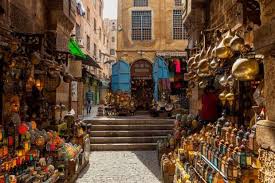

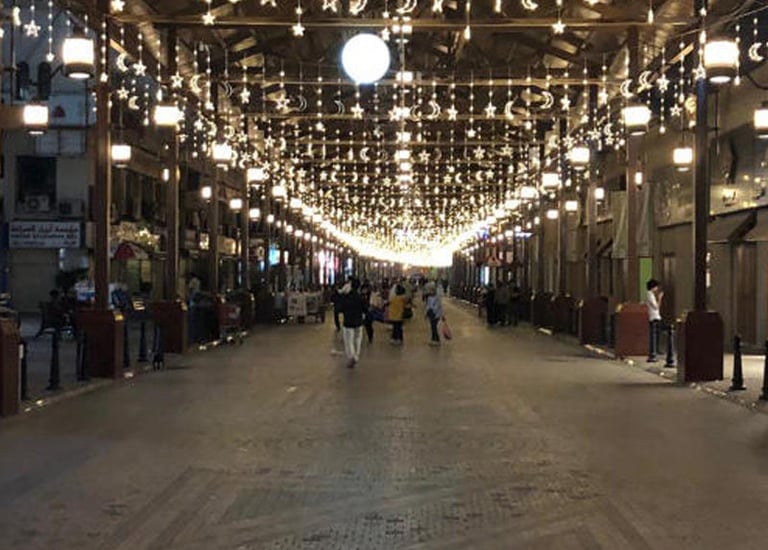

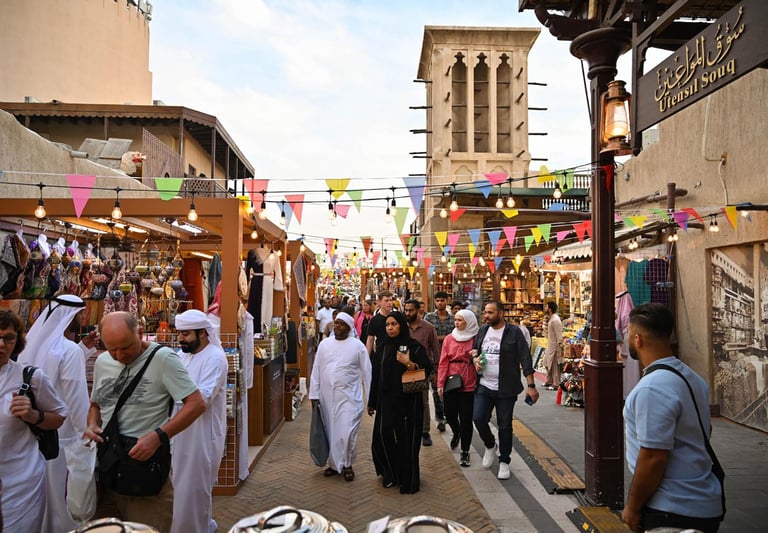

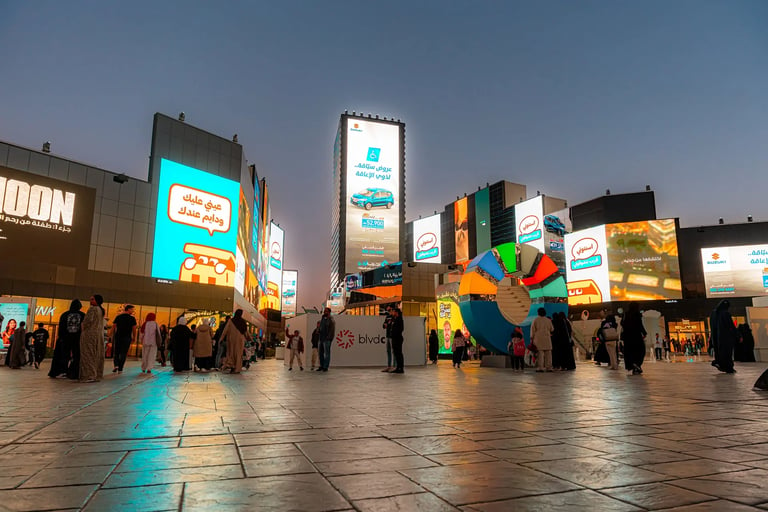

Temporary and sustainable markets in Ramadan
Ramadan Market in Jakarta, Indonesia:
Seasonal temporary markets that appear only in Ramadan, are created from recyclable materials, rely on wooden stalls and environmentally friendly tents instead of permanent concrete structures.
They provide a rich Ramadan experience without leaving a large carbon footprint.
Ramadan Food Markets in Malaysia:
They use temporary booths made of bamboo and recycled wood, and rely on local sources for lighting and cooling, which reduces energy consumption.
The government organizes projects to recycle food waste remaining every day.
There are many ideas that can be applied in the design of sustainable Ramadan markets, such as: integrating open spaces instead of closed markets to improve natural ventilation, using local and sustainable building materials that reduce the need for air conditioning and energy, adopting natural lighting systems through upper windows and glass roofs, recycling waste from food and consumer products during Ramadan, creating temporary Ramadan markets from reusable materials every year, and using solar energy to light the markets and reduce electricity consumption.
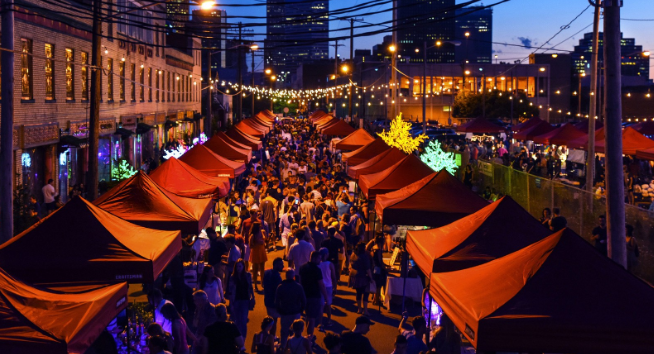

Conclusion:
The performance of architecture in Ramadan represents a point of intersection between architectural engineering and religious, social, spiritual, and economic functions, and this intersection forms a rich field for analysis and development. With the entry of technology into various aspects of life, a new challenge arises: how do we maintain our authenticity in the face of digital transformations?
On the other hand, achieving sustainability today is not just an option, but a necessity to face the challenges of climate change and the increasing consumption of energy and resources. Perhaps the optimal solution lies in reviving traditional urban principles, but with a modern touch that relies on innovation and smart technologies.
As for the holy month, we can ask ourselves whether our Ramadan heritage will remain a main part of the social experience, or whether e-commerce will change its nature? And what will be the role of architecture in the future in this field? Share your vision.
